China has started a grand experiment in AI education. It could reshape how the world learns.
In recent years, the country has rushed to pursue “intelligent education.” Now its billion-dollar ed-tech companies are planning to export their vision overseas.
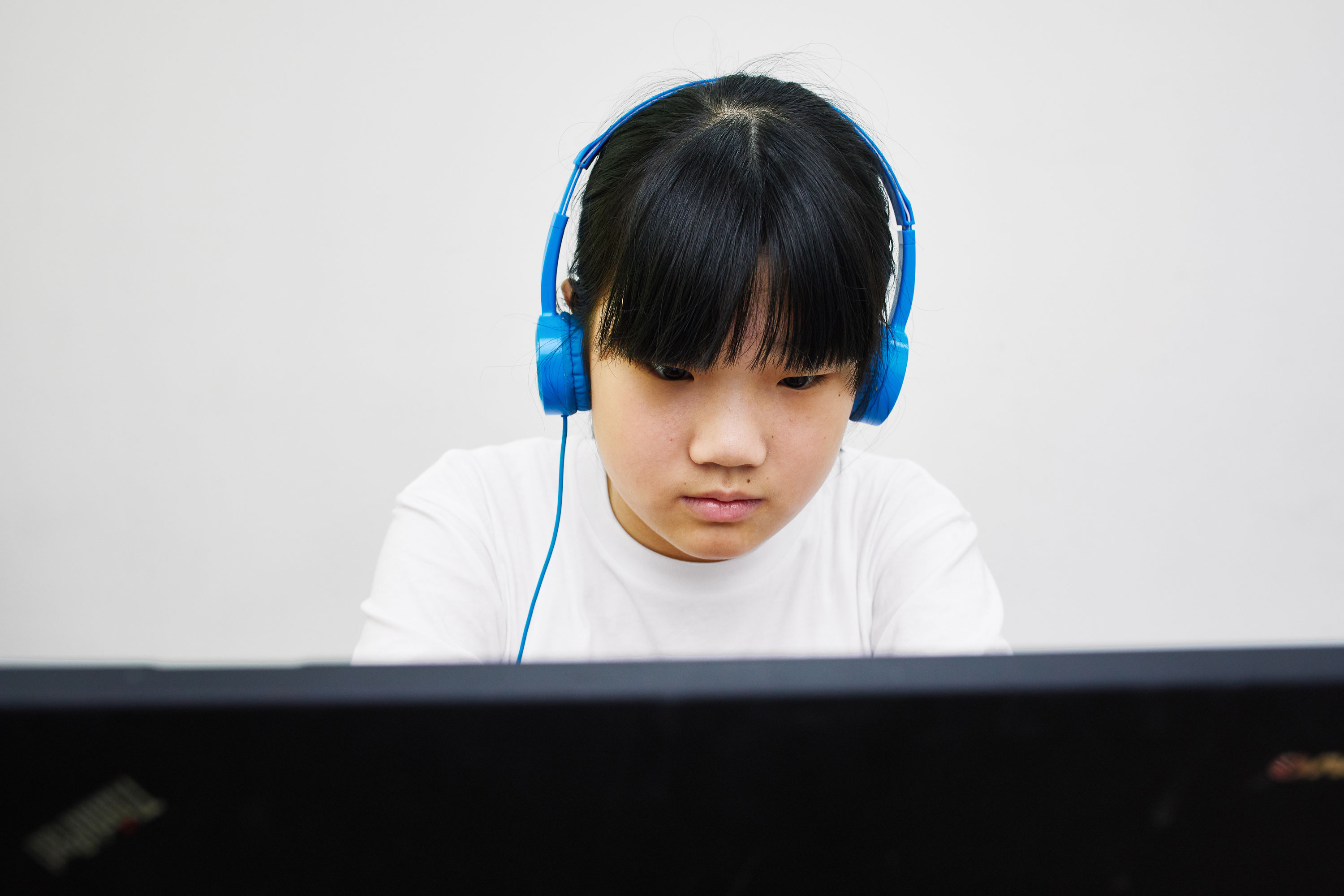
Zhou Yi was terrible at math. He risked never getting into college. Then a company called Squirrel AI came to his middle school in Hangzhou, China, promising personalized tutoring. He had tried tutoring services before, but this one was different: instead of a human teacher, an AI algorithm would curate his lessons. The 13-year-old decided to give it a try. By the end of the semester, his test scores had risen from 50% to 62.5%. Two years later, he scored an 85% on his final middle school exam.
“I used to think math was terrifying,” he says. “But through tutoring, I realized it really isn’t that hard. It helped me take the first step down a different path.”
Experts agree AI will be important in 21st-century education—but how? While academics have puzzled over best practices, China hasn’t waited around. In the last few years, the country’s investment in AI-enabled teaching and learning has exploded. Tech giants, startups, and education incumbents have all jumped in. Tens of millions of students now use some form of AI to learn—whether through extracurricular tutoring programs like Squirrel’s, through digital learning platforms like 17ZuoYe, or even in their main classrooms. It’s the world’s biggest experiment on AI in education, and no one can predict the outcome.
Silicon Valley is also keenly interested. In a report in March, the Chan-Zuckerberg Initiative and the Bill and Melinda Gates Foundation identified AI as an educational tool worthy of investment. In his 2018 book Rewiring Education, John Couch, Apple’s vice president of education, lauded Squirrel AI. (A Chinese version of the book is coauthored by Squirrel’s founder, Derek Li.) Squirrel also opened a joint research lab with Carnegie Mellon University this year to study personalized learning at scale, then export it globally.
But experts worry about the direction this rush to AI in education is taking. At best, they say, AI can help teachers foster their students’ interests and strengths. At worst, it could further entrench a global trend toward standardized learning and testing, leaving the next generation ill prepared to adapt in a rapidly changing world of work.
As one of the largest AI education companies in China, Squirrel highlights this tension. And as one of the best-poised to spread overseas, it offers a window into how China’s experiments could shape the rest of the world.
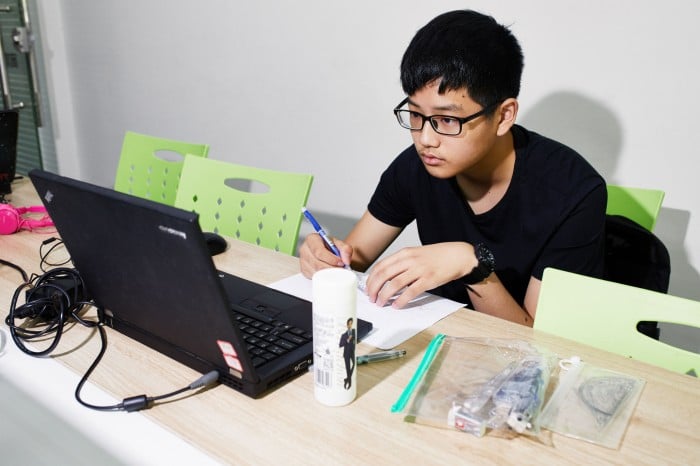
The learning center that Zhou attends, one of the first that Squirrel opened, occupies the second floor of an unassuming building on a busy commercial road in Hangzhou, a second-tier city in Zhejiang province. Company awards line the walls in the stairwell. Further in, large photographs of at least a dozen men are on display: half of them are Squirrel AI’s executives and the others are master teachers, a title bestowed on the best teachers in China, who help develop the company’s curriculum.
The school’s interior decorations are modest. The foyer is small and colorful with lime-green accents. Photos of smiling students hang along the corridor between six or so classrooms. Inside, faded decals of trees and simple mottos like “Be humble” enliven the walls. There are no whiteboards, projectors, or other equipment—just one table per room, meant for six to eight people.
The vehicle of instruction is the laptop. Students and teachers alike stare intently at screens. In one room, two students wear headsets, engrossed in an English tutoring session. In another, three students, including Zhou, take three separate math classes. They work out practice problems on pieces of paper before submitting their answers online. In each room, a teacher monitors the students through a real-time dashboard.
At different points, both teachers notice something on their screen that prompts them to walk over and kneel by a student’s chair. They speak in hushed tones, presumably to answer a question the tutoring system can’t resolve. Though I’m just feet away, I can’t distinguish their words above the soft hum of traffic on the street below.
“It’s so quiet,” I whisper to the small gang of school and company staff assembled for my tour. The Hangzhou regional director smiles with what I interpret as a hint of pride: “There are no sounds of teachers lecturing.”
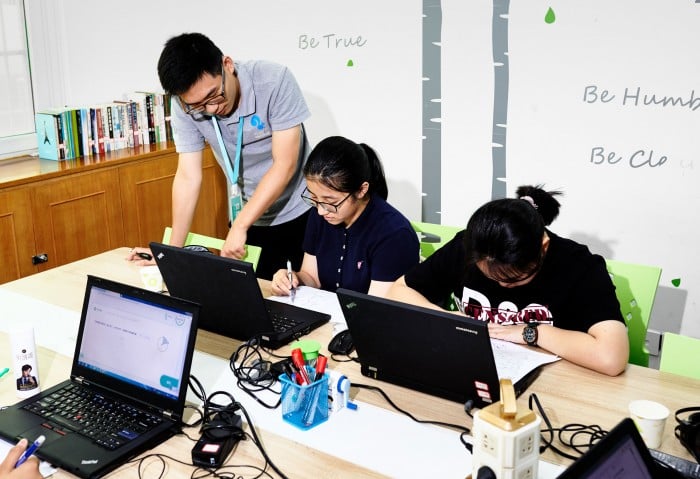
Three things have fueled China’s AI education boom. The first is tax breaks and other incentives for AI ventures that improve anything from student learning to teacher training to school management. For VCs, this means such ventures are good bets. According to one estimate, China led the way in over $1 billion invested globally last year in AI education.
Second, academic competition in China is fierce. Ten million students a year take the college entrance exam, the gaokao. Your score determines whether and where you can study for a degree, and it’s seen as the biggest determinant of success for the rest of your life. Parents willingly pay for tutoring or anything else that helps their children get ahead.
Finally, Chinese entrepreneurs have masses of data at their disposal to train and refine their algorithms. The population is vast, people’s views on data privacy are much more lax than in the West (especially if they can get coveted benefits like academic performance in return), and parents are big believers in the potential of technology, having seen how much it has transformed the country in just a few decades.
Squirrel focuses on helping students score better on annual standardized tests, which taps straight into national gaokao anxiety; more than 80% of its students return year after year, it says. It also designed its system to capture ever more data from the beginning, which has made possible all kinds of personalization and prediction experiments. It heavily markets its technical capabilities through academic publications, international collaborations, and awards, which has made it a darling of the Shanghai local government.
The strategy has fueled mind-boggling growth. In the five years since it was founded, the company has opened 2,000 learning centers in 200 cities and registered over a million students—equal to New York City’s entire public school system. It plans to expand to 2,000 more centers domestically within a year. To date, the company has also raised over $180 million in funding. At the end of last year, it gained unicorn status, surpassing $1 billion in valuation.
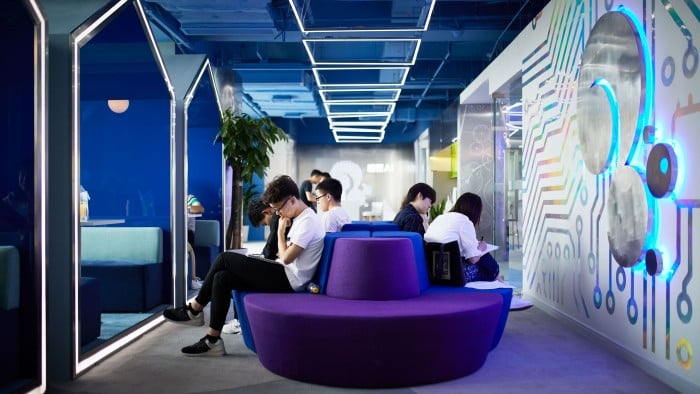
Squirrel isn’t the first company to pursue the concept of an AI tutor. The earliest efforts to “replicate” teachers date back to the 1970s, when computers first started being used in education. Then, between 1982 and 1984, several studies in the US showed that students who received one-on-one human tutoring performed far better than students who didn’t. This set off a new wave of efforts to re-create that kind of individual attention in a machine. The result was adaptive learning systems, which can now be found everywhere from kindergartens to workplace training centers.
Squirrel’s innovation is in its granularity and scale. For every course it offers, its engineering team works with a group of master teachers to subdivide the subject into the smallest possible conceptual pieces. Middle school math, for example, is broken into over 10,000 atomic elements, or “knowledge points,” such as rational numbers, the properties of a triangle, and the Pythagorean theorem. The goal is to diagnose a student’s gaps in understanding as precisely as possible. By comparison, a textbook might divide the same subject into 3,000 points; ALEKS, an adaptive learning platform developed by US-based McGraw-Hill, which inspired Squirrel’s, divides it into roughly 1,000.
Once the knowledge points are set, they are paired with video lectures, notes, worked examples, and practice problems. Their relationships—how they build on each other and overlap—are encoded in a “knowledge graph,” also based on the master teachers’ experience.
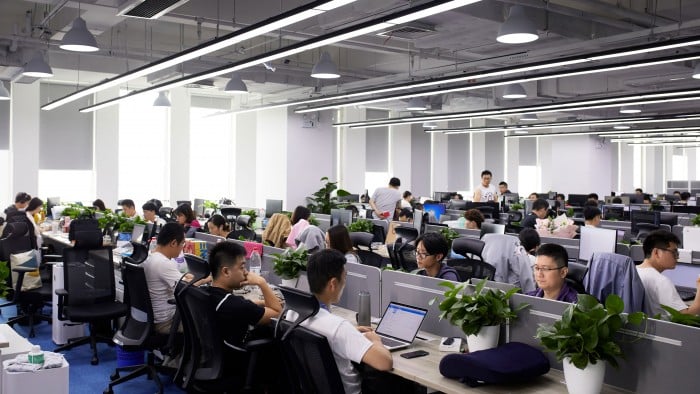
A student begins a course of study with a short diagnostic test to assess how well she understands key concepts. If she correctly answers an early question, the system will assume she knows related concepts and skip ahead. Within 10 questions, the system has a rough sketch of what she needs to work on, and uses it to build a curriculum. As she studies, the system updates its model of her understanding and adjusts the curriculum accordingly. As more students use the system, it spots previously unrealized connections between concepts. The machine-learning algorithms then update the relationships in the knowledge graph to take these new connections into account. While ALEKS does some of this as well, Squirrel claims that its machine-learning optimizations are more limited, making it, in theory, less effective.
Squirrel has offered some validation of its system. In October 2017, for example, a self-funded four-day study with 78 middle school students found that the system was better on average at lifting math test scores than experienced teachers teaching a dozen or so kids in a traditional classroom.
The students I speak to at the learning center have high praise for the tutoring program as well. All are finishing middle school and have been coming to the center for more than a year. One girl, Fu Weiyi, tells me she’s improved far faster than when she got individual tutoring from a human teacher. “Here, I have a teacher both on and offline,” she says. “Plus, the instruction is very targeted; the system can directly identify the gaps in my understanding.” Another student echoes the sentiment: “With the system, you don’t have to do tons of exercises, but it’s still effective. It really saves time.”
While I have to take their words with a grain of salt—the students are hand-picked and give their testimonials under intense supervision—I’m still touched by their relief that they’ve found a formula that works to ameliorate the often brutal academic environment. Zhou Yi’s story, perhaps not coincidentally, also neatly illustrates how Squirrel can help struggling students.
For Squirrel’s founder Li, this vision doesn’t stop at tutoring. He has ambitions to break out of the confines of after-school programming and integrate his curriculum directly into the main classroom. Squirrel is already in discussion with several schools in China to make its system the primary method of instruction.
I try to imagine what this world might be like, and whether we might be better off for it. I ask the students one last question: Is there anything that Squirrel could improve? A long pause. Then: “I wish we had more interaction with our human teachers,” Fu says.
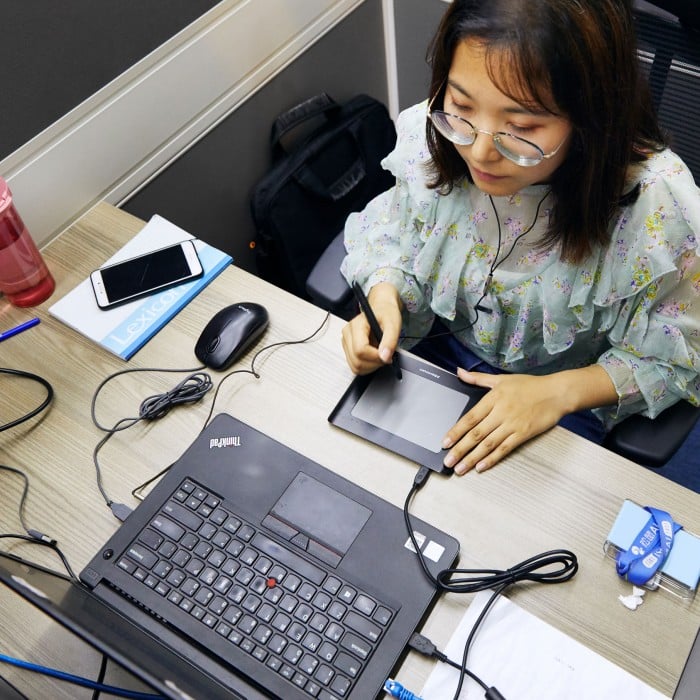

A teacher helping a student via video as part of Squirrel's new remote tutoring program.
Every educational expert I spoke to for this story began by making the same point: to understand how AI could improve teaching and learning, you need to think about how it is reshaping the nature of work.
As machines become better at rote tasks, humans will need to focus on the skills that remain unique to them: creativity, collaboration, communication, and problem-solving. They will also need to adapt quickly as more and more skills fall prey to automation. This means the 21st-century classroom should bring out the strengths and interests of each person, rather than impart a canonical set of knowledge more suited for the industrial age.
AI, in theory, could make this easier. It could take over certain rote tasks in the classroom, freeing teachers up to pay more attention to each student. Hypotheses differ about what that might look like. Perhaps AI will teach certain kinds of knowledge while humans teach others; perhaps it will help teachers keep track of student performance or give students more control over how they learn. Regardless, the ultimate goal is deeply personalized teaching.
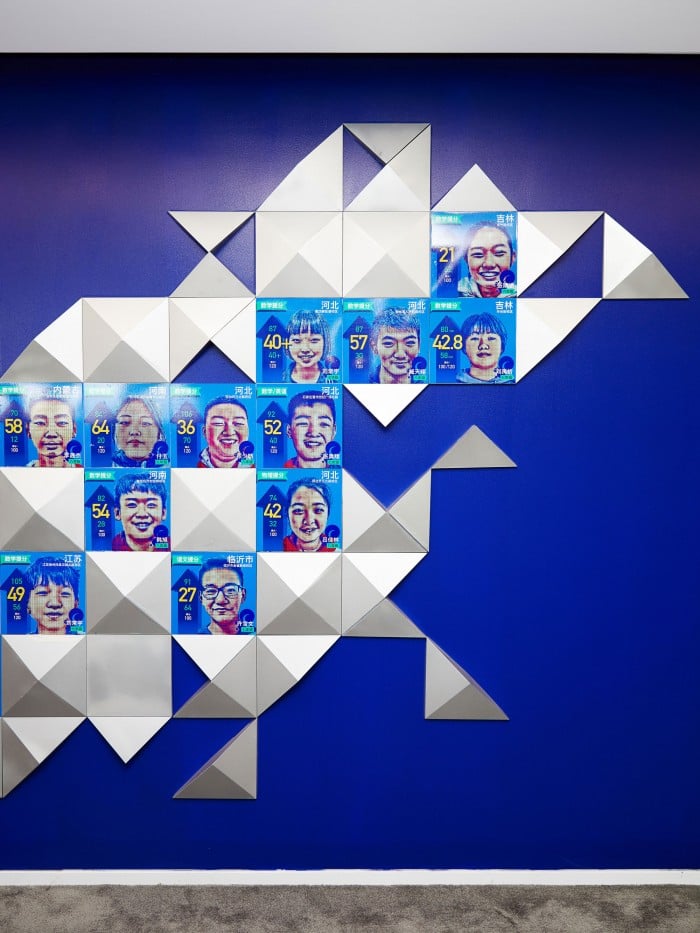
Squirrel’s approach may yield great results on traditional education, but it doesn’t prepare students to be flexible in a changing world, the experts I spoke to say. “There’s a difference between adaptive learning and personalized learning,” says Chris Dede, a professor at Harvard University in the Technology, Innovation, and Education Program. Squirrel is doing adaptive learning, which is about “understanding exactly what students know and don’t know.” But it pays no attention to what they want to know or how they learn best. Personalized learning takes their interests and needs into account to “orchestrate the motivation and time for each student so they are able to make progress.”
Jutta Treviranus, a professor at the Ontario College of Art and Design University who pioneered personalized learning to improve inclusivity in education, breaks it down further. “Personalized learning has a number of levels,” she says: she calls them pace, path, and destination.
If the pace of learning is personalized, students with different abilities are allowed different amounts of time to learn the same material. If the path is personalized, students might be given different motivations to reach the same objectives (“Here’s why statistics is relevant to your love of baseball”) and offered the material in different formats (e.g., video versus text). If the destination is personalized, students can choose, for instance, whether to learn with a vocational school or a university in mind.
“We need students to understand their own learning. We need them to determine what they want to learn, and we need them to learn to learn,” Treviranus says. “Squirrel AI doesn’t address those things at all. It only makes it more efficient to bring all of the students to the same standardized place.”
That doesn’t mean that adaptive learning systems won’t have any place in the 21st-century classroom. David Dockterman, a colleague of Dede’s, believes their strength in training people on structured knowledge is still valuable. But it would be a mistake to make them the predominant “teacher” in the classroom: “The kinds of rote activities—knowledge retrieval, skill acquisition—that are more readily teachable with a smart tutor are also the things that are more readily accomplished by a smart machine,” he says.
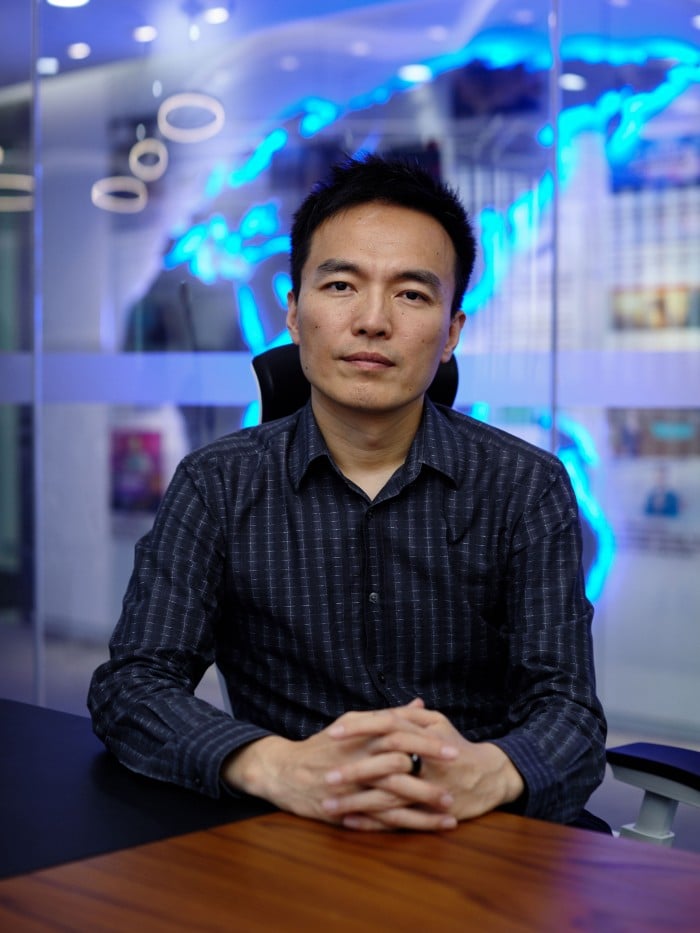
Li, Squirrel’s founder, is tall and lanky and has severe cheekbones. When he speaks English, he punctuates every few sentences with “Right?,” eyebrows raised, to make sure you’re on the same page. When he speaks Mandarin, his words tumble out twice as fast.
A week after my visit to the learning center, I meet him at Squirrel’s headquarters in Shanghai. In the style of an understated showman, he gives me the grand tour. The modesty of the learning center stands in sharp contrast to the office décor here: each wall boasts of different details about the company and milestones it’s reached. Here’s one with all its media mentions. Here’s another with all its awards. And here are some examples of students who were deemed “hopeless” and then saved. I run into another tour before I’ve finished my own.
A few steps past the first door, Li points out a screen to my immediate left playing a TV clip on repeat. It’s a game show featuring a showdown between Squirrel’s tutoring system and a human teacher—one of the best in China, he says. Three of the teacher’s students, whom he has taught for three years, stand alongside him on stage solving problems. The system and the teacher compete to predict which ones they will get right.
Li doesn’t wait for the clip to end to reveal the punchline: “In three hours we understand students more than the three years spent by the best teachers.”
On screen, the teacher looks increasingly crestfallen and humiliated. “He looks so sad,” I say.
“You noticed!” Li laughs.
Much of Squirrel’s philosophy stems from Li’s own experiences as a child. When he was young, he didn’t have very good emotional intelligence, he says, and reading books on the subject didn’t help. So he spent half a year dividing the skill into 27 different components and trained himself on each one. He trained himself to be more observant, for example, and to be an interesting conversationalist (“I spent a lot of time finding 100 topics, so I have a lot of material to talk with others,” he says). He even trained himself to keep smiling when others criticized him. (“After that, in my life, I do not have any enemies.”) The method gave him the results he wanted—along with the firm belief that anything can be taught this way.
Li uses an analogy to lay out his ultimate vision. “When AI education prevails,” he says, “human teachers will be like a pilot.” They will monitor the readouts while the algorithm flies the plane, and for the most part they will play a passive role. But every so often, when there’s an alert and a passenger panics (say, a student gets bullied), they can step in to calm things down. “Human teachers will focus on emotional communication,” he says.
Li thinks this is the only way humanity will be able to elevate its collective intelligence. Entrusting teachers with anything else could risk “damaging geniuses.” He’s playing out this philosophy on his own kids, using Squirrel’s system as much as possible to train them. He boasts that his eight-year-old twin boys, in the second grade, are now learning eighth-grade physics, a testament that his method is working. “Only adaptive systems could make such miracles,” he says.
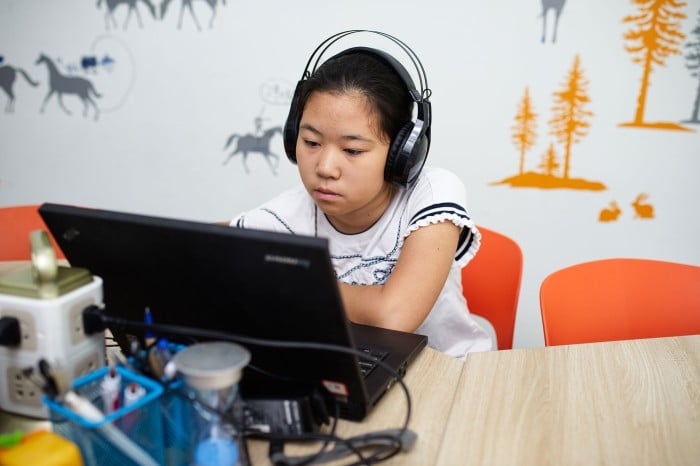
Squirrel is already exporting its technology abroad. It has cultivated its international reputation by appearing at some of the largest AI conferences around the world and bringing on reputable collaborators affiliated with MIT, Harvard, and other prestigious research institutes. Li has also recruited several Americans to serve on his executive team, with the intent of pushing into the US and Europe in the next two years. One of them is Tom Mitchell, the dean of computer science at Carnegie Mellon; another is Dan Bindman, who led the user experience and editorial teams at ALEKS.
Treviranus worries that Squirrel’s educational philosophy is representative of a broader flaw in China’s pursuit of intelligent education: its emphasis on standardized learning and testing. “The tragedy of the China experiments is that they’re taking the country to a point of education that any progressive pedagogue or education system is moving away from,” she says.
But she believes that China also has one of the best opportunities to reinvent a more teacher-friendly, learner-focused classroom environment. It is less entrenched than the West in older models of education and much more willing to try new ideas. “China needs to look at a completely different form of AI,” she says. The question is: What does that mean?
The answer may lie a dozen miles west of Squirrel’s headquarters, across from the Huangpu River that courses through Shanghai. There, Pan Pengkai, a children’s educational expert, is conducting experiments of a different nature.
Pan has been thinking about how to use AI in education for nearly two decades. Fifteen years ago, he founded his first ed-tech company in China after getting his PhD from the MIT Media Lab. Inspired by his experience in grad school, he focused on building tools for learning English. “Innovation comes from difference,” he says. “That’s exactly what China lacks. If you are able to speak multiple languages, you are able to talk to different people; you are able to communicate different ideas.”
Pan now runs Alo7, a K-12 ed-tech company with the same mission of teaching English. Unlike many other firms, though, it seeks to move away from test-oriented learning and instead foster creativity, leadership, and other soft skills. The company offers products and services for both physical and digital classrooms. It has an online learning platform, paired with a collection of textbooks, for example, that help students learn and practice their language skills. It also has a service that connects up to three pupils via video with English tutors abroad for regular group lessons. To date, it has served some 15 million students and teachers and partnered with 1,500 institutions nationally.
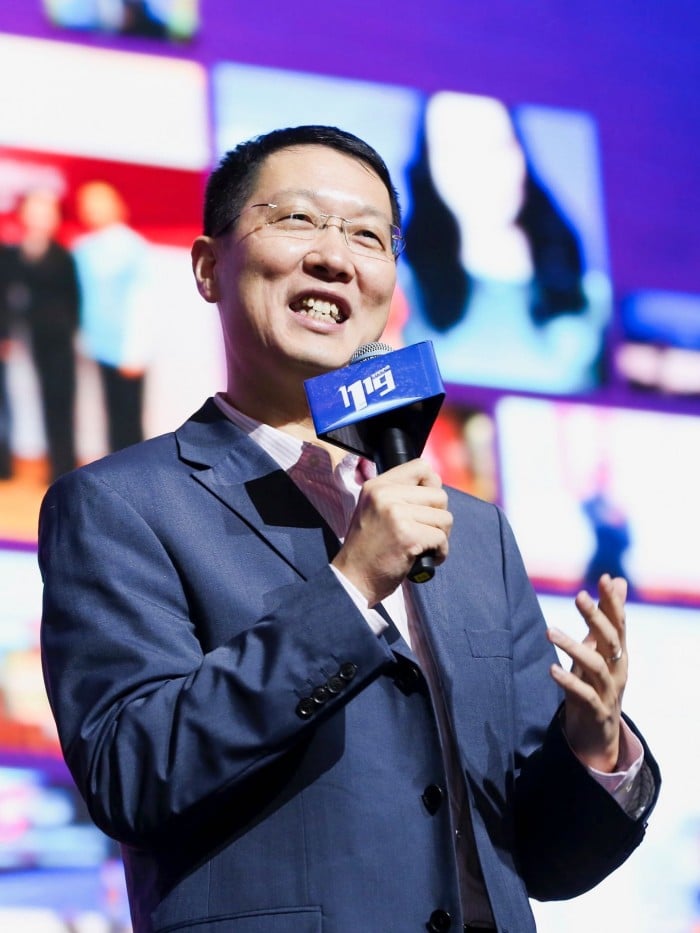
Unlike Squirrel, Alo7’s online learning platform is meant to supplement a traditional classroom. Knowledge that can be exercised through adaptive learning, like vocabulary words, is practiced at home through the app. So are skills like pronunciation, which can be refined through speech-recognition algorithms. But anything requiring creativity, like writing and conversation, is learned in the classroom. The teacher’s contribution is vital. Pan offers a parallel: “There’s lots of medical technology used in hospitals, but we cannot say the machine is better than the doctors. It’s still a doctor’s assistant tool.”
Pan’s ultimate vision for AI in education is to get rid of standardized tests entirely. “Why do we test people for two or three hours to determine if they are good or bad?” he asks. He thinks AI will eventually create flexible learning environments that are as good for sensitive and creative students as for precise and analytical ones. Education will no longer be about competition, he says.
Last year Alo7 began to experiment more. It added face and voice analysis to its video tutoring sessions to produce summary reports of each lesson. Algorithms measure how much time the students spoke English in class, the accuracy of their English pronunciation, and basic indicators of their engagement and joy, such as the number of times they opened their mouth to speak and laugh. Earlier this year, the company created several physical classrooms equipped with cameras and microphones to produce similar analyses. Teachers get reports on their own performance, too.
I go see one of Alo7’s intelligent classrooms for myself. It’s small but bursting with color. The walls are illustrated with the company's mascots, five cartoon companions with distinct personalities, which appear throughout the company’s educational materials. There are neither tables nor chairs, just a bench that runs along the back wall. At the front are a whiteboard and two TVs for displaying the day’s curriculum.
There are no classes in session, but a company employee plays me some short clips of elementary school classes. In one, six students sit on a bench and practice saying the names of different animals. “Bird, bird, bird!” they chant with their teacher as she flaps her arms like wings. “Turtle, turtle, turtle!” they continue as the screen changes its display to a cartoon turtle. The teacher-student interactions take the foreground; the AI purposely fades, unnoticed, into the back.
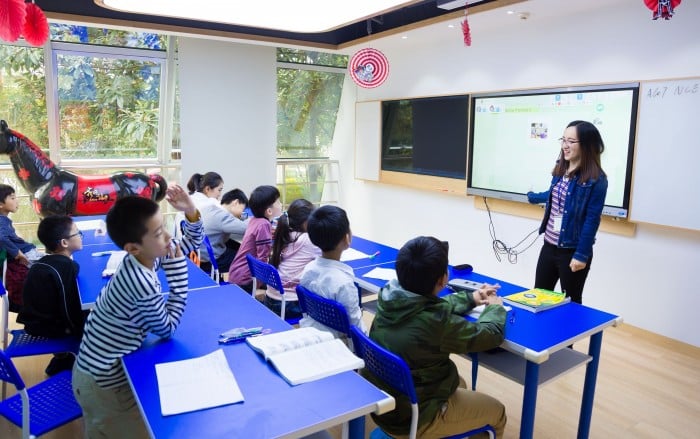
Dede says the kind of data generated in an intelligent classroom could be useful, but he cautions that cameras and other sensors could also be misused to judge a student’s emotions or state of mind, applications that have little grounding in science and could lead to over-surveillance. Pan agrees that it’s important to be careful: “That’s why we provide the data mainly for teachers and not students, because we haven’t yet run scientific tests.”
Pan tells me he doesn’t have plans to expand Alo7 beyond China. The domestic market alone is enough of a challenge when he’s selling an education philosophy that goes against the mainstream. But he’s begun to see a shift in the national conversation. As government leaders have sought new ways to stimulate innovation, the idea of a “quality-oriented education”—one that emphasizes creativity and the liberal arts—has gained momentum.
In February of last year, China’s education ministry passed a series of reforms, including stricter licensing for tutors, aimed at reducing the obsession with testing. Earlier this month, the government also unveiled a set of guidelines to focus more on physical, moral, and artistic education, and less on exams. Though critics point out it still hasn’t eliminated the gaokao, Pan is optimistic about its intent to change. Alo7 is also ready to help the country search for new paths forward.
“We want to change the future of Chinese education with technology,” Pan always says. China’s current mass experiment in AI education, and the choices it must make, might also change education for the world.
Corrections: Alo7’s video-tutoring service follows a group format; it’s not one-on-one. After publication, Squirrel clarified that Dan Bindman was the editorial director at ALEKS, not a co-founder as stated on Squirrel's website, and both companies use fewer knowledge points than the former previously shared. ALEKS also has more data than Squirrel.
Deep Dive
Artificial intelligence
Sam Altman says helpful agents are poised to become AI’s killer function
Open AI’s CEO says we won’t need new hardware or lots more training data to get there.
What’s next for generative video
OpenAI's Sora has raised the bar for AI moviemaking. Here are four things to bear in mind as we wrap our heads around what's coming.
Is robotics about to have its own ChatGPT moment?
Researchers are using generative AI and other techniques to teach robots new skills—including tasks they could perform in homes.
An AI startup made a hyperrealistic deepfake of me that’s so good it’s scary
Synthesia's new technology is impressive but raises big questions about a world where we increasingly can’t tell what’s real.
Stay connected
Get the latest updates from
MIT Technology Review
Discover special offers, top stories, upcoming events, and more.